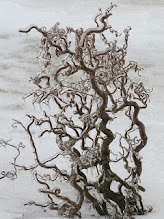 |
| Harry Lauder Walking Stick in Winter |
Perennial
Growth: to 10 ft.
Culture: Sun to partial shade; drought tolerant
Flowers: Unremarkable
Grown for unusual twisted, corkscrew branches
Hardy: Zones 4b-8 (Franklin County is Zone 6b)
Winter interest plant
----------------------------------------------------------------
This intriguing shrub (Corylus avellana 'Contorta') lends plenty of winter interest when sited to show off its silhouette with twisted, corkscrew branches. Every Harry Lauder's Walking Stick was propagated from a single plant that was discovered in an English hedgerow in the 19th century.
Not its best feature, it does have textured green leaves that fade to pale yellow in fall. Hardy in zones 4B-8, it has a slow growth rate and can reach 10’. It has a high tolerance for drought, likes sun or part shade and does well in most soils.
A member of the hazel family, it produces flowers called catkins which may hold on into winter, though it does not produce nuts. Usually grafted onto Turkish hazel (Corylus colurna) rootstock, gardeners need to prune off any suckers to prevent the plant reverting to the rootstock characteristics.
 |
| Icy coating is beautiful winter display. |
You want to know why the name, don’t you? Presumably
it was named after Harry Lauder, an early 20th C. English
vaudevillian who carried a crooked walking stick with him on stage.








No comments:
Post a Comment